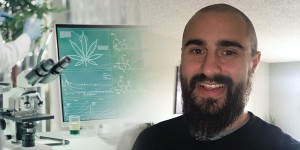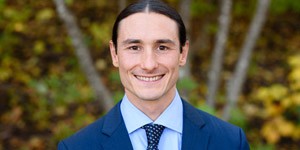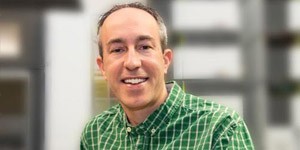By Yuval (Tuby) Zolotov

Yuval (Tuby) Zolotov is a medical cannabis researcher and a PhD student at the School of Public Health at the University of Haifa. He completed his Master in Health Administration at Bar Ilan University where he investigated adherence to medical cannabis among licensed patients in Israel. Before joining academia in 2012, Yuval was a licensed Patient Instructor and has been involved with the local industry since its inception. While working on his thesis – Medical Cannabis Recommendation: Understanding and Predicting Physicians’ Behavior – Yuval is also involved in various research projects.
Meet the Experts is a series of interviews conducted by experts from the field of Cannabis to world leaders in research and clinical practice of Cannabis as medicine.
Roger Pertwee has three degrees from the University of Oxford: MA (in biochemistry), D.Phil. (in pharmacology) and D.Sc. (in physiological sciences). He is now an Emeritus Professor at the University of Aberdeen, where he is still actively engaged in scientific research.

He is also co-chairman of the International Union of Basic and Clinical Pharmacology (IUPHAR) Subcommittee on Cannabinoid Receptors, a co-ordinator of the British Pharmacological Society's Special Interest Group on Cannabinoids, a co-founder of the International Cannabinoid Research Society (ICRS), an invited scientific advisor on cannabinoid pharmacology/therapeutics to the Beckley Foundation, and a visiting Professor at the University of Hertfordshire.
Roger Pertwee's research focuses on the pharmacology of cannabinoids. He is the author of numerous review articles on the cannabinoids and is often invited to speak on the pharmacology of cannabinoids at international conferences. He is also interested in the therapeutic potential of cannabinoids. He has served too as President of the ICRS (1997-1998 and 2007-2008), and as Chairman of the International Association for Cannabinoid Medicines (IACM; 2005-2007), and is also currently ICRS International Secretary (1992-2018) and a member of the IACM Board of Directors.
Yuval Zolotov: Professor Pertwee, we are much honored to have this interview with you. By now you are studying cannabinoids for several decades, and you have contributed to a number of breakthroughs in the science that stands behinds the cannabis plant. Can you please tell us how it all started?
Roger Pertwee: While I was doing my undergraduate degree course in Biochemistry at Oxford University, I joined the British Army Royal Engineers section of the University's Officers' Training Corps which gave me the opportunity to do a diving course with the Royal Engineers and so became a qualified shallow-water diver. As a result, I became aware of the fact that people can get intoxicated just by breathing air at high pressure. After obtaining my degree in biochemistry, I decided that I wanted to study the pharmacology behind this phenomenon, and was lucky enough to be taken on as a D.Phil. student at Oxford University to work on a project in which I was able to investigate the pharmacology of diving gases at high pressure. After I had completed this project, my D.Phil. supervisor, who was an expert on the pharmacology of general anaesthetics, suggested that I stay on in his lab as a postdoctoral researcher to seek out anaesthetic-like actions, as well as other pharmacological properties, of some of the "cannabinoid" constituents of cannabis. This was in the late 1960s, and so at a time when we didn't know much about the pharmacology of cannabinoids.
YZ: What kind of cannabis did you have at that time in the lab to study?
RP: It was not a cannabis plant. I actually never worked directly with herbal cannabis. But back at that time it was possible to extract cannabinoids from Tincture of Cannabis which was then a legal cannabis-based medicine in the UK. Around the beginning of the 1970s, new medications appeared and there were also concerns raised about the recreational use of cannabis which had become a major problem around that time. As a result, this cannabis-based medicine was unfortunately eventually banned in the UK.
YZ: Is there one specific project that was particularly important or exciting for you?
RP: There were several exciting projects, one of the most memorable of which was a collaborative project with Prof. Raphael Mechoulam and his team that had been prompted by the discovery of cannabinoid CB1 receptors, and that had been set up because Prof. Mechoulam was searching for an endogenous activator of these receptors in pig brain, and because I had just developed a new assay for CB1 agonists - drugs which activate these cannabinoid receptors. This collaborative project led to the discovery of the endogenous CB1 agonist, anandamide. Our findings from this project were published in the journal Science in 1992, and this was the first paper ever about an endogenous compound that is produced by mammalian tissues and can activate cannabinoids receptors. Today anandamide and other endogenous cannabinoid receptor ligands are known as endocannabinoids, and together with the cannabinoid receptors that they target, constitute the endocannabinoid system.
YZ: What makes the endocannabinoid system interesting and exceptional in your opinion?
RP: We know that the endocannabinoid system is involved in many different bodily processes. Interestingly, cannabinoids are made in the body only when and where they are needed to produce particular effects, effects that are often beneficial. Also, they are not stored in the body, and indeed, shortly after interacting with their pharmacological targets, they are broken down by enzymes. The consequences of exposing the body to cannabis are of course quite different, because when people take cannabis the THC it contains indiscriminately activates all cannabinoid receptors in the body at the same time. Such "flooding" of the endocannabinoid system does not occur when endocannabinoids are released endogenously because they are then only produced when and where needed so that their effects on bodily processes are much more selective, resulting for example in "autoprotective" effects such as the alleviation of pain.
YZ: Is there anything that you did not know before and learned just recently about the endocannabinoid system?
RP: We recently discovered in my lab that cannabinoid CB1 receptors contain "allosteric sites" as well as "orthosteric sites". For an analogy, think about a radio. We can turn a radio on and off, which is an analogy of activating "orthosteric" sites on cannabinoid CB1 receptors, and we can also turn up the volume of the sound coming from the radio to some extent, which is an analogy of the consequence of increasing the dose of the activating drug (an orthosteric agonist). What we have discovered is that it is also possible to increase or decrease the volume level that is produced by a particular dose of a CB1 agonist. Thus, we have discovered that as well as orthosteric sites, cannabinoid CB1 receptors also contain allosteric sites that can be targeted with drugs to strengthen or weaken the orthosteric activation of these receptors by particular doses of compounds like THC and anandamide. So we may be able to develop new medicines which can target these "allosteric sites" and thus strengthen or weaken cannabinoid CB1 receptor-mediated effects produced by endogenously released endocannabinoids. Indeed, together with scientists from the USA, we have already developed a drug (a CB1 "positive allosteric modulator") which acts in this way to alleviate signs of pain in an animal model. This drug has, however, not yet been tested in humans.
YZ: Which paths of research do you find most promising?
RP: The starting point of one of these paths is the cannabis plant, which has been found to produce many compounds, including a large group known as "phytocannabinoids", and this has prompted a lot of research. Moreover additional compounds are regularly being discovered in and isolated from cannabis plants. Consequently, some of my own research has long been directed at seeking out pharmacological actions displayed by phytocannabinoids and by synthetic analogues of some of these compounds, one of my objectives being to seek out actions of potential therapeutic relevance, the discovery of which might lead on to the development of important new medicines.
YZ: Which cannabinoids are you currently studying? And what can you tell us about their activities?
RP: One phytocannabinoid that I have long been investigating is tetrahydrocannabivarin (THCV), which has only a slightly different structure from THC, and yet which I have found differs pharmacologically from THC by blocking the CB1 receptor at doses at which it activates the CB2 receptor. That combination of actions could be very promising for treating several disorders, including diabetic kidney damage known as renal nephropathy, a possibility that we are currently exploring here in Aberdeen. Just two other examples of phytocannabinoids that some of my collaborators and I have been studying are cannabidiol (CBD) and cannabidiolic acid (CBDA), the compound from which CBD is formed in cannabis. We found that both of these phytocannabinoids can target a receptor called the 5HT1A receptor, which is a type of serotonin receptor. The resulting findings have revealed a lot of potential medical uses for either or both of these compounds. For example, together with a Canadian research group, we recently found CBDA to be effective at producing 5-HT1A-mediated reductions of signs of nausea in animals. Interestingly, CBDA seems to show even greater promise than CBD as a medicine for the treatment of certain disorders. This is because it may have a broader "therapeutic window". Thus, both CBD and CBDA display what is called a "bell-shaped dose-response curve" for their production of 5-HT1A mediated effects. What this means is that they produce no effect not only at very low doses but also at very high doses. They are each only effective over a specific range of intermediate doses. And this range is broader for CBDA than for CBD. Unfortunately, CBDA is not very stable, a problem that prompted us to compare CBDA with a much more stable synthetic CBDA analogue (HU-580). The results we obtained suggest that, at least in animal models, this analogue is even better that CBDA at reducing signs of nausea and can also decrease signs of anxiety. Whether HU-580 would be a medicine that is both effective and safe in human patients remains to be seen.
YZ: Some synthetic cannabinoids have been legally available on the markets in some places. What is your perspective about this?
RP: Well, yes, this is quite a problem. In the UK they are not legal anymore, and I think that's a very good thing. These are molecules that activate the CB1 receptor, and many of them can do this much more strongly than THC. Thus, THC is what is known as a partial CB1 receptor agonist, which means that even at very high doses the size of any effect resulting from its activation of these receptors is quite small – much smaller than the sizes of the effects that at least some of the synthetic cannabinoids you mentioned can produce when they activate CB1 receptors. Going back to my radio analogy, the volume of the sound coming from a radio can be turned up to a much higher level by these compounds than by THC. Such strong activation of the CB1 receptor is thought to be very harmful, for example to the kidney, and indeed, people have died from kidney failure after taking some of those synthetic cannabinoids. I think it's important to warn people against using these drugs because they really do seem to be very dangerous.
YZ: What is your opinion about self-medicating with cannabis?
RP: I truly believe that people who self-medicate with cannabis may be a source of information which could be very useful. I think that at least some of these people have discovered therapeutic uses of cannabis which we didn't know about. But certainly, at the end of the day the claims that people who self-medicate with cannabis make, need to be checked out in proper clinical studies. We can take multiple sclerosis (MS) as an example. Currently this is one of only a very few medical indications for which there is a licensed cannabis-based medicine (Sativex®, Y.Z). But very interestingly, the development of Sativex as a medicine was influenced by reports from MS patients who were self-medicating with cannabis.
YZ: Can you share with us more details?
RP: In the late 1980s or early 1990's, I came across newspaper articles written by an MS patient, using a pseudonym, about her self-medication with cannabis for the relief of her MS symptoms. I decided to contact the writer of this article and discovered that she was in touch with many MS patients who were self-medicating with cannabis, and who were members of what was then called the "Alliance for Cannabis Therapeutics". A few colleagues and I sent out a questionnaire via this patient group to numerous MS patients, and we published the results obtained from this survey in 1997 in a paper that we called "The perceived effects of smoked cannabis on patients with multiple sclerosis". I think this paper helped to encourage the British Medical Association and the Select Committee on Science and Technology of the UK House of Lords to seek out and consider existing evidence that cannabis-based medicines might have therapeutic potential. It also strengthened the case for developing a new cannabis-based medicine with which to perform clinical trials, a challenge which was met by a then newly founded company called GW Pharmaceuticals, and led in a relatively short time, to the development, and to the approval of the cannabis-based medicine, Sativex.
YZ: Do you have any position or opinion about the legal status of cannabis itself?
RP: This is really not within my area of expertise, as I am not, for example, a politician. That said, I think we do need to make sure that we maximize the benefits and minimize the harms of cannabis and cannabinoids throughout the world. I do not think that this has been even nearly achieved – there is in my view still a lot to be done. The situation today is, in some countries, quite chaotic. However, I am a preclinical cannabinoid pharmacologist and not a policy maker and so focus on other objectives such as the gathering of pharmacological information about cannabis, phytocannabinoids, endocannabinoids and synthetic cannabinoids, particularly information that would hopefully facilitate the development of new cannabinoid medicines that have very favourable benefit-to-risk ratios, and that meet currently unmet medical needs.
YZ: Thank you very much for having this interview for us.


